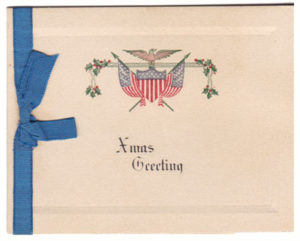
While he saved no Valentine’s Cards, my grandfather Corporal I. G. Coley of Company A, 315th Engineers, AEF, kept this Christmas card from the Red Cross in his hometown of Bryson, Texas.
The history of Valentine’s Day – and the story of its patron saint – is shrouded in mystery. We do know that February has long been celebrated as a month of romance, and that St. Valentine’s Day, as we know it today, contains vestiges of both Christian and ancient Roman tradition. But who was Saint Valentine, and how did he become associated with this ancient rite?
Valentine or Valentinus (in Latin), all of whom were martyred. One legend contends that Valentine was a priest who served during the third century in Rome. When Emperor Claudius II decided that single men made better soldiers than those with wives and families, he outlawed marriage for young men. Valentine, realizing the injustice of the decree, defied Claudius and continued to perform marriages for young lovers in secret. When Valentine’s actions were discovered, Claudius ordered that he be put to death.
Other stories suggest that Valentine may have been killed for attempting to help Christians escape harsh Roman prisons, where they were often beaten and tortured. According to one legend, an imprisoned Valentine actually sent the first “valentine” greeting himself after he fell in love with a young girl – possibly his jailor’s daughter – who visited him during his confinement. Before his death, it is alleged that he wrote her a letter signed “From Your Valentine,” an expression that is still in use today.
Although the truth behind the Valentine legends is murky, the stories emphasize his appeal as a sympathetic, heroic and – most importantly – romantic figure. By the Middle Ages, perhaps thanks to this reputation, Valentine would become one of the most popular saints in England and France.
At the end of the 5th century Pope Gelasius declared February 14 St. Valentine’s Day. It was not until much later, that the day became definitively associated with love. During the Middle Ages, it was commonly believed in France and English that February 14 was the beginning of birds’ mating season, which added to the aura that Valentine’s Day should be a day for romance.
Valentine greetings were popular as far back as the Middle Ages, though written Valentine’s didn’t begin to appear until after 1400. The oldest known valentine still in existence today was a poem written in 1415 by Charles, Duke of Orleans, to his wife while he was imprisoned in the Tower of Landon following his capture at the Battle of Agincourt. The greeting is now part of the manuscript collection of the British Library in London, England. Several years later, it is believed that King Henry V hired a writer named John Lydgate to compose a valentine note to Catherine of Valois.
In addition to the United States, Valentine’s Day is celebrated in Canada, Mexico, the United Kingdom, France and Australia. In Great Britain, Valentine’s Day began to be popularly celebrated around the 1600s. By the middle of the 1700s, it was common for friends and lovers of all social classes to exchange small tokens of affection or handwritten notes, and by 1900 printed cards began to replaced written letters due to improvements in printing technology. Ready-made cards were an easy way for people to express their emotions in a time when direct expression of one’s feelings was discouraged. Cheaper postage rates also contributed to an increase in the popularity of sending Valentine’s Day greetings.
Americans probably began exchanging hand-made valentines in the early 1700s. In the 1840s, Ester A Howland began selling the first mass-produced valentines in America. Howland, known as the “Mother of the Valentine,” made elaborate creations with real lace, ribbons and colorful pictures known as “scrap.”
In the late 19th century and early 20th century the most elegant and beautiful cards were handmade in Germany. With the arrival of the Great War and the brutal invasion of Belgium, the market for German valentine greetings went down the drain, only to be replaced by workshops in Brooklyn.
With the American Expeditionary Forces (AEF) well entrenched in the heart of France, American girls looked for Valentines for their special beaux and for friends. Many were cute cartoon figures; others still sported red cloth and lace, while others became practical encouragement for Hooverizing. Hooverizing was a scheme to encourage Americans to eat less meat, less wheat, less chocolate, and less of all the foods they loved. The purpose was to feed AEF troops, along with starving French, Belgians, Poles, and other allies throughout the continent.
Getting supplies, troops, equipment, materiel and ammunition to France was a huge job. Space on ships was crowded beyond belief. So how many valentines made it to the front? Mail service was erratic at best; all outgoing mail was screened for information the enemy might use, and where did the Dough Boys buy cards for their sweethearts Stateside? Certainly not in Germany. Did the Red Cross or YMCA sell them? I think not. Sometimes it’s fun to wonder about these trivial matters.
